
|
GREATEST FILM SCENES 1930s (2) |
|
# 24. A Night at the Opera (1935) This Marx Brothers' musical comedy has one of the most celebrated scenes in all screen comedy - the classic, slapstick crowded stateroom scene. Seedy entrepreneur and swindler Otis B. Driftwood (Groucho Marx) sails to New York on the S. S. Americus with the New York Opera Company to represent his interests toward wealthy dowager Mrs. Claypool (Margaret Dumont). On board, Driftwood finds himself in Suite # 58, a telephone-booth-size stateroom on the cruise ship. When the steward attempts to cram a steamer trunk into the cozy room, Driftwood asks: "Wouldn't it be simpler if you just put the stateroom in the trunk?" He is aghast to see three stowaways, Fiorello (Chico), Riccardo (Allan Jones), and a sleeping Tomasso (Harpo) curled up in the bottom drawer of the trunk - they pop out into his tiny compartment. To keep them quiet, he steps into the hallway and places an order with the steward for meals - supplemented by additional orders for food items from behind the stateroom door. A persistent procession of people from the ship's staff parade into the tiny shoebox cabin no bigger than a closet: two chambermaids to make up the room, an engineer to turn off the heat, a manicurist to trim Driftwood's nails, the engineer's large assistant, an inquiring young woman wandering around for her Aunt Minnie and asking to use the phone, a determined, gum-chewing, cleaning washwoman to mop up, and the stewards with the meal order. Each of the occupants that are entangled together must find space in a nook or cranny of the miniscule stateroom. The grande dame, Mrs. Claypool shows up in her finest costume and opens the door, letting loose the above-mentioned in an avalanching torrent of bodies into the corridor. [The other classic scene in the film is "The Party of the First Part" contract scene and the line about a "Sanity Clause".] |
  
|
|
# 25. Top Hat (1935) The dancing partnership of Ginger Rogers and Fred Astaire, stretching over seven years for RKO Studios, has produced a priceless number of memorable dance duets. Most film afficionados consider it (their fourth film) to be their finest film together. In a centerpiece solo, Astaire dances the sensational Top Hat, White Tie, and Tails number as part of the second act of his London show - it is the quintessential tuxedo-clad dance, backed by a top-hatted, tuxedoed, male chorus line. Together, the duo performs the romantic adagio Cheek to Cheek. He breaks into song in mid-sentence: "Heaven, I'm in Heaven. And my heart beats so that I can hardly speak. And I seem to find the happiness I seek. When we're out together dancing, Cheek to Cheek..." First, they dance in the company of others on a crowded dance floor and then dance/drift across a bridge to a deserted, circular ballroom area. All alone in a dreamlike setting, they perform a romantic dance together. Dale's ankle-length gown, (the most famous of all Rogers' dance dresses), light, ice-blue satin covered with ostrich feathers, sheds as they whirl around. Beautifully, they stretch out an arm to each other (his left, her right), leading to her twirling spin into him. Briefly, they repeat their earlier tap-dancing routine from the bandstand, performing side by side. Several times she bends deeply backwards in his arms during their choreographed dance, surrending to his seductive, luring attraction. Mixed with standard ballroom dance positions, they also leap and turn boldly, separate, spin, and then return "cheek to cheek." After a climactic ending with a full orchestral burst, the dance ends as they come to rest against a wall. They affectionately gaze at each other, while Jerry slowly twiddles his thumbs. |
 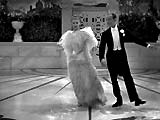
|
|
# 26. Modern Times (1936) In Charlie Chaplin's last 'silent' film, he battles technology. The Tramp (Charlie Chaplin) has a disastrous, nightmarish lunch at a food-eating machine (another most-memorable sequence) - a mechanical, automated, aerodynamically-styled, silent feeding machine which features a revolving table, an automaton soup plate, an automatic food pusher, a revolving low and high gear corncob feeder, and a hydro-compressed sterilized mouth wipe. Back at his factory worker job in the late afternoon after rejoining his co-workers on the assembly line, his job is to tighten bolts on an endless series of machine parts - he is a small cog in the factory. The key to successful nut-tightening is to perform his movements and tasks with clocklike tempo and precision. From his work station on the assembly-line, he holds wrenches in both hands to tighten nuts on a long stream of steel plates carried on the conveyor belt production line. The boss has ordered production increases: "Section 5 - give 'em the limit," so the conveyor belt is sped up - a hilarious, frenzied scene as he makes an heroic effort to keep up. Under the strain of the job, he finally goes beserk, slowly driven insane by the assembly line. He literally lies prone on the belt and is dragged, swallowed and eaten up by the whizzing wheels, gears, and cogs of the monstrous machine. His body snakes its way through the gears until the production line's direction is reversed and he finally emerges free - coughed out of the machine. He has gone completely crazy and insane. [The film's final image of the Tramp walking into the sunrise is indelible.] |
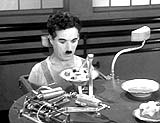 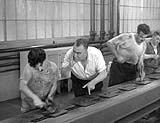  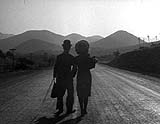
|
|
# 27. Camille (1936) There are few romantic tragedies that capture the funereal death scene as well as this exquisite film. The 19th century Parisian courtesan, Marguerite 'Camille' Gautier (Greta Garbo), a notorious, kept-woman with an avaricious life of self-indulgence and frivolity succumbs to consumption in the presence of the handsome, young Armand Duval (Robert Taylor). The prolonged scene commences with the confinement of the dying Marguerite on her bed. Her weakened, wan face is framed by her pillow - she rallies to get out of bed when she learns her lover has come. The vulnerable woman gets out of bed and painfully makes her way to a chair. There, her nurse brings her camellias to pin to her lap, and brushes her hair. Rapturous, impatient, and hoping to look perfect, Camille begs: "I'll be beautiful again when I'll be well again, won't I?" In an exquisite, classic deathbed scene, she makes a great effort to stand and greet Armand as he enters. Her eyes and face are joyous and bright for their reunion. But in moments, she is exhausted and debilitated - he sweeps his fragile love into his arms as she falls. He babbles to her about his reaffirmation of love and promises to stay with her forever - now that he understands her love-as-renunciation. He plans for their happy future together, beginning with a trip to the country where she can get well. She gains sustenance and power from his ardor and support. Marguerite falters however - she goes limp and cries that she isn't strong enough. After he calls for the doctor, places her in a chaise and kneels at her side, she experiences sadness for a love that she has lost forever in the temporal world. But she's not self-deluded - her death will release them from an untenable relationship into a more spiritual, mystical relationship: "Perhaps it's better if I live in your heart, where the world can't see me. If I'm dead, there'll be no staying of our love." She signals death when her eyes burst open once. She crumbles and falls lifeless, but remains tranquil with a gentle smile on her face. Armand looks at her and notices she has already passed away. He is horrified that this is the end. He buries his face on her breast, weeping. The film ends with a final fade-out, close-up shot of Marguerite's lovely, radiant face - imperishable in death. [Only the deathbed scenes in Dark Victory (1939) and Wuthering Heights (1939) come close to equaling this scene - see below.] |

|
|
# 27a. Dark Victory (1939) At the conclusion of this film, after bidding her departing husband Dr. Steele (George Brent) goodbye, and also comforting her sorrowful best friend Ann (Geraldine Fitzgerald), a dying Judith (Bette Davis) enters her house - and at the foot of the stairs, she tells her maid Martha (Virginia Brissac): "I'm going up to lie down now." Feeling her way along, she starts climbing the stairs - one last time - she stops midway to embrace and say goodbye to her two dogs Daffy and Don. She haltingly climbs further toward her bedroom, kneels and offers a final prayer by her bedside. Martha has followed her and pulled the blind on the window, shutting out the rays of sunlight. Judith asks: "Is that you, Martha?" She eases herself onto her bed and lies down, telling her housekeeper to be dismissed, without hysterics: "I don't want to be disturbed." Martha covers her with a comforter and then respectfully leaves the room and closes the door. Judith triumphantly and victoriously faces the end alone and dies in a dignified manner. A camera frames a close-up of Judith's sightless, staring face and then slowly blurs out-of-focus, signifying the end of her vision - and death. A heavenly chorus of voices accompanies her entrance into the void. |

|
|
# 27b. Wuthering Heights (1939) Heathcliff (Laurence Olivier) runs up and sneaks into Cathy's (Merle Oberon) bedroom, where together they share one of the most memorable, luminous deathbed scenes ever filmed. They pledge their enduring, undying love and become reconciled after so many years of mutual unhappiness and bitterness. They passionately hug and kiss each other, finally revealing their truest emotions to each other:
Heathcliff vows to stay with Cathy as her strength ebbs. He hears her claim that he was always the only man she ever loved. She asks that Heathcliff pick her up: "Take me to the window. Let me look at the moors with you once more, my darling. Once more." Heathcliff carries her in his arms to the window, where they look out on the moors and the Crag where they played together as children. Before slumping into his arms after breathing her last breath, they make a pact to be together for eternity. She promises to wait for him there in death until they are reunited again one day: "Heathcliff, can you see the Crag over there where our castle is? I'll wait for you 'til you come." |
 
|
|
# 28a. Gone With the Wind (1939) One of the most famous and popular films of all time is director Victor Fleming's Civil War epic. Against the sweeping, panoramic drama of the war is the passionate, tumultuous story of Scarlett O'Hara (Vivien Leigh) and the dashing, charming Charlestonian Rhett Butler (Clark Gable). She is forewarned about him when he is first noticed as the "nasty dark one" with a "most terrible reputation" standing alone at the foot of the staircase during the Wilkes barbecue at the Twelve Oaks plantation. Dressed in an elegant black suit, Butler exchanges a cool, challenging stare with Scarlett. She notices him undressing her with his eyes: "He looks as if - as if he knows what I look like without my shimmy." |

|
|
# 28b. Gone With the Wind (1939) Another powerful scene during the war evokes irrevocable feelings: Scarlett races to the enormous open-air 'hospital' of Atlanta's railroad depot to find Dr. Meade to assist in Melanie's (Olivia de Havilland) delivery. A close-up of Scarlett's face shows her horrified reaction to what she sees. She picks her way through thousands of wounded and dead Confederate soldiers strewn around the railroad depot, in one of the classic, most incredible and memorable scenes ever filmed. In the spectacular moving crane shot, the camera slowly pulls back to show more and more of the defeated and crippled army in the hot sun. It finally comes to rest on a close-up of a torn and tattered Confederate flag which waves defiantly and bravely over the remnants of the army, a vivid representation of the death throes of the Old South. [And lastly, the scene of Rhett Butler's exasperated parting from Scarlett at their front door. Scarlett asks: "Rhett, if you go, where shall I go? What shall I do?" Without sentimentality, (in a daring, almost-disallowed taboo line), he cooly responds for the last time: "Frankly, my dear, I don't give a damn!"] |
 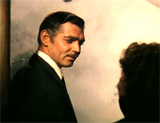
|
|
# 29. Gunga Din (1939) The greatest rousing adventure tale and film of all-time is George Stevens' classic, based upon Rudyard Kipling's poem of the same name - a tribute to a courageous water carrier (Sam Jaffe) who accompanies British Army veterans in India as they battle against a fanatical, murderous Indian cult in the late nineteenth century. In the film's stirring and poignant ending, Gunga Din - who longs to be a regimental bugler, but has been mortally wounded by a bayonet, gathers all his courage and strength and crawls painfully to the top of a domed tower. There, with his last ounce of stamina, he blows a warning from a bugle to warn approaching British troops that they are about to be ambushed at the entrance to a rocky pass. As he finishes giving his warning, a bullet hits him, and he slumps - the final sounds from his bugle are ones of his fading death before he expires and falls from the tower. In the epilogue, the loyal, lowly water-boy is praised and admired by a colonel for his deserved heroism as one of the "honored dead," and he is posthumously appointed as a regimental corporal. The last stanza of Kipling's poem is read as tribute: "...Though I belted you and flayed you, By the living Gawd that's made you, You're a better man than I am, Gunga Din!" The film ends with a superimposed image of a proudly smiling and saluting Gunga Din, fully costumed in a British soldier's uniform. |

|
|
# 30. Mr. Smith Goes to Washington (1939) The classic filibuster scene at the conclusion of Frank Capra's film has to rank as one of the most-finely acted sequences ever recorded. After almost twenty-four hours of filibustering, with an agonizingly, pathetically hoarse voice but also with an indomitable spirit, a weary, pleading Jefferson Smith (James Stewart) has a few more exhortations for the Senators who have returned to the Senate chamber. In an extraordinary metaphor emphasizing the Capitol Dome high above him, Smith imaginatively suggests re-positioning the lady of the Dome back to an ethical center where she belongs: "And it's not too late. Because this country is bigger than the Taylors or you or me or anything else. Great principles don't get lost once they come to light. They're right here. You just have to see them again." When baskets, wire barrels, and bundles of stacks of 50,000 "Taylor-made" phony telegrams from Senator Paine's (Claude Rains) state are brought in and deposited in the front of the Senate chamber, Paine holds up a fistful, telling Smith that they all demand that he yield the floor and give up his filibuster. In one of the most powerful scenes ever filmed, Jefferson staggers forward in disbelief to look at the telegrams, pawing through them and desperately looking for some evidence of support. In a symbolic crucifixion stance, he grabs two large fistfuls and holds them out. In a hoarse voice, he turns toward Senator Paine and delivers an impassioned speech, accusing Paine face-to-face of betraying his ideals. Then with heart-stirring courage, Smith finishes his heroic speech with the immortal eloquent words: "You think I'm licked. You all think I'm licked. Well, I'm not licked, and I'm gonna stay right here and fight for this lost cause even if this room gets filled with lies like these, and the Taylors and all their armies come marching into this place. Somebody'll listen to me. Some..." Smith faints and collapses on the floor, dumping a basket of telegrams over onto himself. His supportive friend Saunders (Jean Arthur) screams from the gallery. With a strained look on his face, Senator Paine rushes from the Senate floor toward the vestibule/cloakroom as Smith is treated. Two or three shots ring out, and Paine is seen struggling with other Senators. They prevent him from killing himself, as he screams in a public confession that he is unable to live with his guilt-ridden conscience any longer: "I'm not fit to be a Senator. I'm not fit to live. Expel me! Expel me! Not him." Conscience-stricken and in a fit of remorse, Senator Paine re-enters the Senate floor and admits that everything Smith said was true, exonerating him and the American political system. |
   
|
|
# 31. Stagecoach (1939) In director John Ford's first modern Western, John Wayne began his fertile acting partnership with the director (in his first major western role) with the inspired, legendary scene of his first appearance - in a role that made him famous and launched him as the most durable Western hero. As Ringo Kid, an outlaw who is seeking revenge for the murder of his father and brother by the Plummers, he is first seen 'holding up' the stagecoach (with an assortment of characters) on its way to Lordsburg. Along the way after rounding a turn, a rifle shot is heard, and a tracking shot zooms in (losing focus for a moment) for a large clear closeup of Ringo Kid standing tall from the perspective of the moving stagecoach. The camera rapidly tracks in on his face. Ringo is twirling and re-cocking his Winchester rifle in one hand, shouting out: "Hold it!", while holding his saddle in the other hand. He is standing in the middle of the desert by the trail, stranded without a horse. Ringo is wearing a paneled, placket-front shirt with a neckerchief, and jeans with its pants legs rolled up outside of the boots. [The stirring chase across the salt flats at the film's conclusion, with dare-devil stunts performed atop charging horses, is equally momentous.] |
 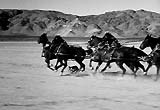
|
|
# 32. The Wizard of Oz (1939) In the much-beloved film is the indelible image of Dorothy (Judy Garland), her dog Toto, the Scarecrow (Ray Bolger) who needs a brain, the Tin Woodsman (Jack Haley) who desires a heart, and the Cowardly Lion (Bert Lahr) who desperately wants courage. They break into spirited song as they link arms and dance through the woods singing: "We're Off to See the Wizard" - this single film sequence has been irrevokably imprinted on everyone's consciousness. With the Wicked Witch of the East's ruby slippers on her feet, Dorothy is off to seek advice on the best way home from the all-powerful Oz, the ruler of the Emerald City. Meanwhile, the Wicked Witch of the West (Margaret Hamilton) gazes into her crystal ball high up in her broken down castle to follow their progress. With the captain of her evil crew of wicked monkeys at her side, she cackles gleefully. She concocts sorcery and other menacing elements to take possession of the ruby slippers. Her plan is to cause sleep-inducing flowers in a poppy field to poison them: "Now my beauties. Something with poison in it I think. With poison. But attractive to the eye and soothing to the smell. Poppies. Poppies. Poppies will put them to sleep. Sleep. Now they'll sleep." [Other scenes qualify as tie-breakers: Dorothy's singing of her beloved, haunting and plaintive, but immortal song "Over the Rainbow." Dreaming, yearning and wistfully longing for a trouble-free, fascinating, far-away world beyond her home-land, she strolls from a bale of hay (which she leans on), to an old wheel (which she pulls on), to a discarded buggy (which she and Toto sit on) as she sings. Or the Wicked Witch's memorable death scene, as she is reduced to a puddle of vaporous clothing in front of everyone, crying out: "You cursed brat. Look what you've done. I'm melting! Melting! Oh, what a world! What a world! Who would have thought a good little girl like you could destroy my beautiful wickedness." Unforgettable.] |
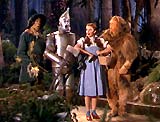 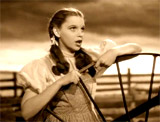 
|
1950s (1) | 1950s (2) | 1960s | 1970-90s |
|